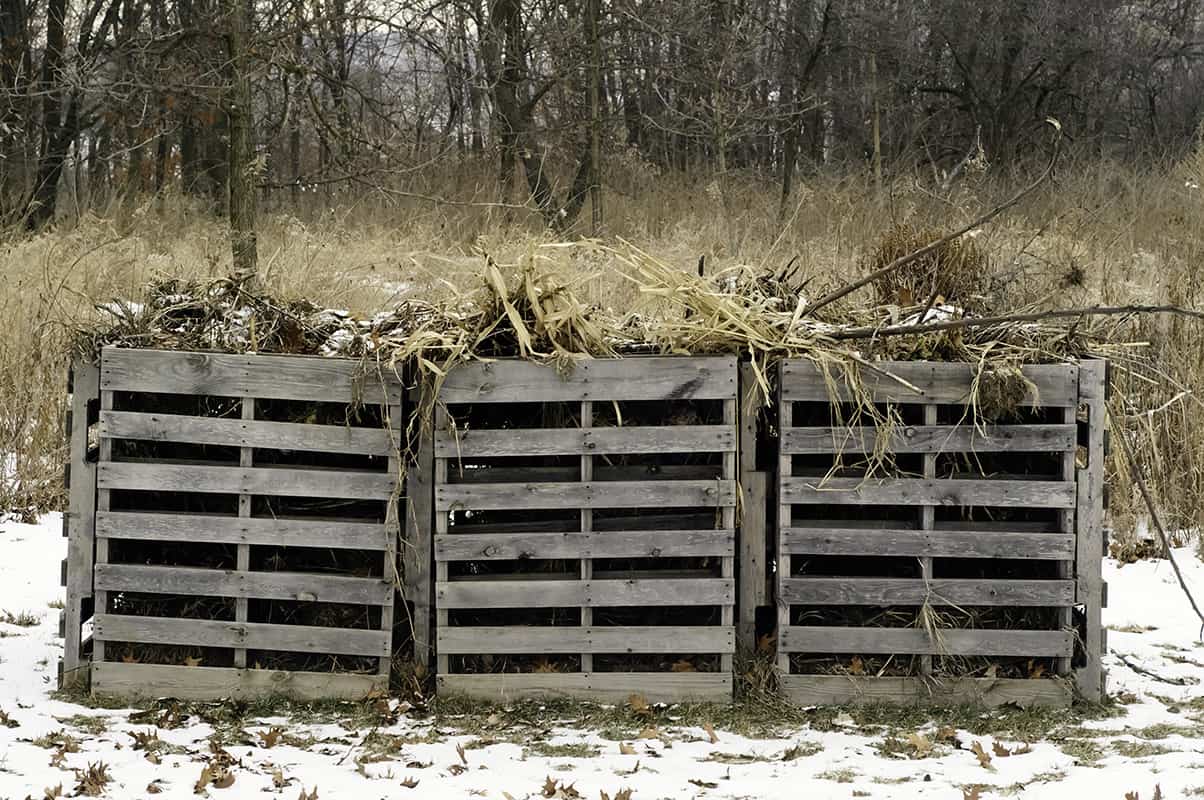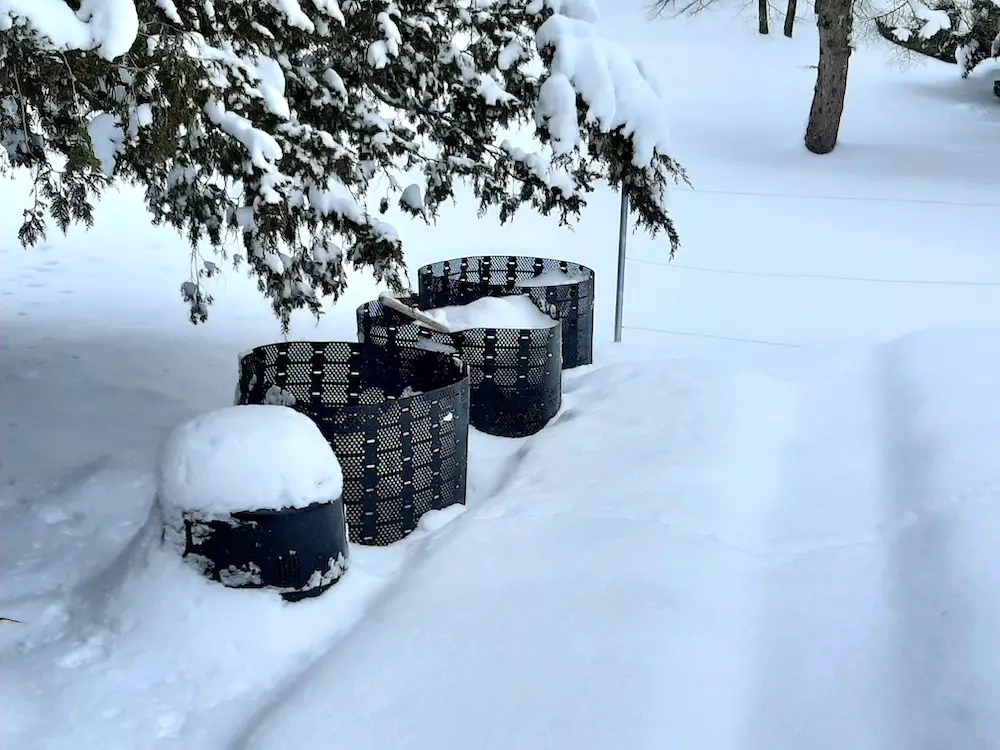Composting may be easier to accomplish in summer when temperatures are at their peak; however, winter composting is still possible and here are a few tips for success.
Start by purchasing an appropriate bin, with a tight lid designed to retain heat and protect against cold winds. Add plenty of insulating material such as leaves, straw or cardboard in order to help retain warmth within the bin.
Use a tarp to insulate your pile
As temperatures cool off, composting may slow significantly; however, you can keep it going by providing your pile with insulation to retain heat produced when it rots while also protecting against excess wetness in winter months.
Utilizing a tarp as part of your compost insulation strategy is one of the easiest and most efficient ways to insulate it. Not only will tarps trap heat inside of them, they’re great at protecting from snowfall, raindrops and freezing conditions from washing through and flooding out your pile. Plus, their presence will protect it from rodents or any other animals who might try nibbling away during colder months!
A tarp can be purchased at any home improvement store or garden centre and comes in various sizes to fit the bin you have in mind. A larger one could cover an entire compost pile while smaller versions can cover only individual heaps or can even sit atop bins themselves.
An effective way to insulate your compost pile is with leaves or straw, which will also help regulate temperature in your heap and accelerate decomposition. Make sure the layer is no more than 6 inches deep; alternatively you could try flattened cardboard and old carpet as insulation materials.
If you don’t own a bin for your compost pile, any container with adequate drainage will do. This makes dropping food scraps into it much simpler while helping prevent ground water from flooding into the pile and disrupting microbes crucial to speeding up its processes.
For this task, the ideal container would be a galvanized trash can; however, other empty containers such as 5-gallon buckets may also work. Drill or poke holes into the bottom of each container in order to increase airflow.
Keep it moist
Summer heat drives the decomposition process in a compost pile, while in winter cold and moisture may halt that process. To keep your compost pile going during this season, it must be regularly aerated, insulated, and moistened to remain active.
Insulating a winter compost pile should follow similar principles as when creating any other bin or heap. Pile up layers of insulation materials such as straw, dried leaves, cardboard or even hay bales around it in order to keep it warm and dry while adding another layer of absorbent materials such as shredded paper or sawdust as necessary for any additional moisture absorption.
Cover your pile with a plastic tarp to prevent snow, rain and ice from inundating it, while also reflecting sunlight to help speed up heating up. Fit the tarp loosely so you can check aeration as needed while providing some degree of protection from the elements.
When using a traditional bin or heap, aim to add at least 12 inches of brown material (such as straw, shredded paper or woody twigs) before introducing any kitchen scraps or green materials like leaves. Layer them alternatingly; this process may take longer in winter but when spring arrives it should yield rich, balanced compost that’s ready for use!
Having a tumbler or similar system for composting will make the process simpler, but regular piles still work well enough if added with layers of green and brown materials regularly. This will keep the pile hot and moist throughout winter so you’ll end up with well-balanced compost in time to use for gardening use come spring. Remember to stay away from woody branches such as pine needles, spruce or juniper as these may slow the process down too much.

Make sure it’s a hot pile
Composting during winter requires creating and maintaining a hot pile. Otherwise, microbes won’t be active enough to decompose properly and the compost won’t decompose as desired. To increase temperature levels in your pile, try adding layers of carbon-rich materials – leaves, twigs or even shredded paper work well – which allow microbes in your compost to absorb and retain heat, while also helping decrease odor.
An effective strategy for finding brown material more quickly during the fall would be stockpiling it during this season, rather than waiting until spring and summer when its availability may be less certain. By doing this, you will save both time and energy when searching for this color during winter months.
As one way of keeping the pile hot, avoid adding too many green kitchen scraps. Doing so could result in an unpleasant aroma in the compost pile, so turn it periodically or add finished chicken/steer manure/blood meal/alfalfa pellets into it in order to increase nitrogen and promote microbial activity.
Covering your pile with a tarp can also provide great assistance. Covering helps prevent moisture loss in dry climates while blocking wind from blowing over and cooling it down.
If a cover is unavailable, try piling straw bales or hay around your compost pile as insulation. Another option would be creating a barrier of logs around it to add insulation.
Prevent evergreen tree branches from being added to your compost by using a wood chipper on them or any plants treated with herbicides and any plant materials treated with heavy doses of herbicide.
As part of your winter compost pile plan, it’s advisable to keep a stockpile of brown material on hand to add throughout. Now is an ideal time to use up all those leaves and twigs collected from around your yard and garden! In addition to providing carbon for heating purposes, these materials also aerate and increase temperature levels within your pile.
Keep it covered
Keep your compost covered during winter to help it remain warm. Whether your pile is in the ground or an outdoor bin, covering is key to trapping warmth and moisture within. In addition, covering it with a tarp can prevent rain or snow from washing away nutrients. Specialized duvets or hot water bottles may be used instead – however I prefer natural solutions over those involving chemicals.
Though many gardeners stop their composting efforts when the temperature drops, it is possible to continue doing it as long as conditions remain suitable. While additional preparation might be required, the microbes that perform decomposition will continue to thrive and continue working provided conditions remain suitable.
Wherever there is heavy winter rainfall or snowfall, keeping a pile well-insulated is particularly essential. Moisture control becomes one of the greatest challenges associated with winter composting in these regions; rain soaks into the ground and is quickly absorbed by compost piles or bins, so proper covering must be ensured if rain soaks into soil too deeply to be contained by protective material such as logs or straw bales; an alternative would be layering dry leaves over an entire compost bin for moisture control purposes.
Make sure to add sufficient greens and browns, such as dried shredded leaves or paper, to create a pile that is at least six to eight feet in diameter and as tall as it will go. A larger pile will provide more surface area for bacteria to work their magic while making turning easier with pitch fork or potato fork. Be sure to cover it completely.
Once a pile has reached an appropriate temperature, it can be used to amend soil or top-dress gardens and yards. As decomposition slows, mixing and turning may still be required, but in about one year’s time spring planting should be possible.

